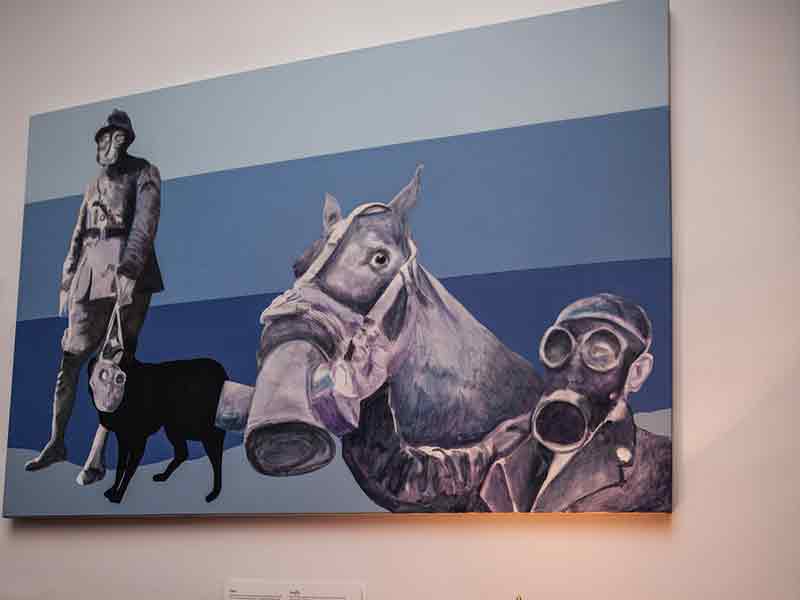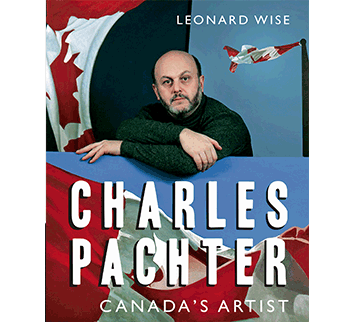The final photograph in Charles Pachter: Canada’s Artist portrays the artist reclining on an antique davenport, sunshine streaming in through the window, illuminating a satisfied smile.
A fitting finale to the biography written by Leonard Wise, the image – shot at the Moose Factory, his studio, gallery and domain – inspires one to ponder whether it depicts Pachter basking in the glow of incredible artistic and personal accomplishments, or luxuriating in the liberating exposé of his life’s jumble of joyous and gritty details.
Whatever the reader’s interpretation, the image illustrates Pachter’s métier as a self-promoting raconteur.
The biography’s conversational tone reflects Pachter’s vocal expressiveness and his humorous, occasionally sad, takes on certain incidents and his handling of them.

In my interview with him, Pachter commended Wise for months of sleuthing through the archives of the Thomas Fisher Rare Book Library at the University of Toronto, to which Pachter had donated some 70 boxes of documents and letters, including correspondence between himself and author Margaret Atwood.
‘when you enter your last quarter, you should make generous gestures to inspire younger artists’
“Why – as a venerable Officer of the Order of Canada, and recipient of three honorary doctorates – does a biography appeal?” I asked.
Perching his glasses on his head, Pachter said, “I recalled reading Jasper Johns’ diary, stuff on Andy Warhol, and several books by and about David Hockney. At 74, I feel grateful to be part of that canon. I think that when you enter your last quarter, you should make generous gestures to inspire younger artists, to help show them that they can find a way for themselves. When other artists read my life story – and see that I told it like it was, with difficulties and successes – their lives will be qualitatively different, but they’ll be able to relate to it.”
READ: AN APP FOR ALL SEASONS: BEREAVEMENT MINYAN VIA WHATSAPP
The biography leads with two provocative articles that skilfully précis Pachter’s personality and accomplishments. In an eloquent foreword, distinguished writer and art museum curator Tom Smart describes Pachter as “an artist of many paradoxes” whose “art is woven into the very fabric of his country’s iconography and public consciousness.” Besides noting Pachter’s Royalist affections and “notorious paintings of Her Majesty sitting astride a moose,” Smart praises Pachter for ultimately influencing and incubating Toronto’s local art scene in the 1970s and 1980s.
Margaret Atwood’s Appreciation, originally published as the foreword to Bogomila Welsh-Ovcharov’s monograph Charles Pachter (McClelland & Steward, 1992), paints intimate vignettes of their flourishing relationship and how it felt to “come of age as an artist in Canada of the ’50s and ’60s” when serigraphs of Group of Seven landscapes hung in every classroom. Further, she mentioned how the collaborations between them enhanced both of their careers.
The story of Pachter, born in 1942 to Sara and Harry Pachter, is coloured with the Yiddishisms and jokes of his Jewish immigrant grandparents and Canadian-born parents. A budding artist at heart by age 12, Pachter’s inspiration grew on a trip to New York during the pop art era, when he visited the Guggenheim, the MOMA and galleries displaying abstract impressionist works by Willem de Kooning, Jackson Pollock and Mark Rothko. When he said he aspired to be a painter, his mother replied, “You want to paint? Paint the bridge chairs.” Meanwhile, his parents acquiesced and provided lessons in art, music and drama.

by Leonard Wise
Published by Dundurn Press
In retrospect, Pachter’s meeting with Atwood at Camp White Pine in 1959 – where he taught art and she, nature – seems auspiciously destined. Over time, he illustrated six of her poetry collections, including the critically praised Journals of Susanna Moodie.
Pachter had his first solo exhibition of silkscreens at the Pollock Gallery on Markham Street at age 19. About then, he began to question his sexual orientation. Wise chronicles Pachter’s sexuality with various women and men, his anguish and self-acceptance, and ends with Pachter’s endearing feelings for his partner, Keith Lem.
In the early 1970s, when Warhol was painting Campbell’s soup cans and Johns American flags, Pachter started painting the streetcars held in the Wychwood Avenue barns. In the harsh winter of 1971, he flew north to Cape Dorset, Baffin Island to teach lithography to the Inuit people of the West Baffin Eskimo Co-op.
When Pachter learned that Queen Elizabeth would visit Niagara-on-the-Lake to open the new Shaw Festival Theatre in June 1973, he felt inspired to paint the Queen on a moose. The signature painting, Noblesse Oblige, which depicts the queen saluting atop a moose, became the first in a series of now celebrated paintings – never mind some of its early, denigrating reviews.
In the 1970s, Pachter’s savvy combination of real estate acumen and social smarts inspired him to create an incubating environment for Toronto talents in the Queen Street West area. His roster of tenants at the Artery co-op gallery and Artists Alliance resounded with important Canadian artists, writers and journalists. When Pachter purchased an old farmhouse and 100-acre retreat in Oro-Medonte, north of Barrie, it became a hub for luminaries in the literary and arts scenes. His social gatherings inspired several paintings, including Six Figures in a Landscape.
Illustrated with impressive images of works that showcase the artist’s oeuvre of talent, as well as photographs of people and places, Pachter’s biography resonates with the highs of praise and lows of criticism, his sink to depression and his indomitable spirit that helped him rise above it. When his flag paintings faced brutal criticisms, he hilariously created fake arts critics Don Rouge-Humber and Avon St. Laurent to applaud his work. Ultimately, Pachter benefited from the uplifting support of major collector/philanthropists.
Pachter’s story and legacy extends beyond this biography to MOFO – as he calls his Moose Factory of Orillia art studio – and his redevelopment of the nearby Huronia site. He is dedicated to turning Huronia into a cultural campus for creative and performing arts, hoping to create a haven akin to Alberta’s Banff Centre or Massachusetts’ Tanglewood.
For all his shtick and stories, Pachter appreciates his status as an artist and feels empathy for those aspiring. His eagerness to cultivate a place to nurture would-be artists’ skills is as flashing as his paintings of the Canadian flag. His work leaves little time to recline on the davenport.
